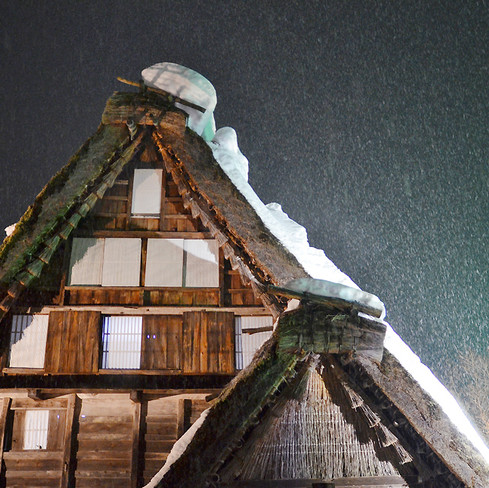Winter Japan Day 1 - Singapore to Nagoya to Takayama
- AK
- Mar 1, 2015
- 4 min read
Updated: May 2, 2019

The Minka and the Monkey
With the soundtrack of Tokyo Drift still playing in my ears since my last post, there is no better time for me to continue on Japan Hour and flood myself with all things Japan like the Great Wave off Kanagawa.
Honestly, I've never been on an all-winter holiday till now. I've seen bits of snow here and there but have never walked in flurries, with fluffy flakes constantly falling from the sky and sprinkling on my face. On impulse, we decided to get our butts off this scorching island and make a trip to Japan before the snow melts and makes way for the spring of 2015.
I guess for most people, Hokkaido seems like the choice destination for a winter wonderland holiday. However, images of snow-capped gassho-zukuri minka houses and Japanese macaques bathing in steaming hot spring came to my mind instead.
Quite simply and quickly, the itinerary had developed around these two destinations - to visit the vernacular minka houses in the UNESCO World Heritage Site of Shirakawa-go and the snow monkeys in the valley of Jigokudani.
And for a change, I shall not bore readers with my usual long-winded stories. This shall be an easy to read, day-by-day pictorial travel journal that brings you through the trip, covering the sights, the transport, the food, and some tips and useful information. Hopefully, it could serve as a guide for planning your next holiday if you are thinking of visiting the minka and the monkey.

Day 1 - Singapore to Nagoya to Takayama Day 2 - Takayama Day 3 - Takayama (Shirakawa-go) Day 4 - Takayama to Matsumoto (transfer) to Nagano Day 5 - Nagano (Jigokudani) Day 6 - Nagano to Tokyo Day 7 and 8 - Tokyo Day 9 - Tokyo to Nagoya Day 10 - Nagoya to Singapore
Singapore to Nagoya



(Above) A warm and hearty breakfast to start the day at Maccaroni. And my much-needed morning caffeine topped with a kawaii froth.
Nagoya to Takayama

After breakfast, we found our way to the connected train station and hopped on the JR Limited Express Wide View Hida train to Takayama (高山). Do buy a reserved seat in the Green Car with the 2+1 seat configuration (above photo). And if you wish to enjoy the 2.5 hour journey with a panoramic view of the beautiful countryside, get your seat in Car No.10, which is the leading car. Don't get worried when the train starts moving off from Nagoya in a backward direction. It would change direction after 20 minutes at Gifu and you could look forward to the rest of your journey, literally.
















(Above) Every January and February, the Village holds a winter illumination event every evening where all traditional houses get bathed in LED lights, some with slow colour-changing effects. The entire village felt surreal especially with the dense pouring snow when I was there. There were also significantly less tourists after 7pm and the whole place was simply magical.
Wrapping up my first day at Hida no Sato with a cup of hot sweet sake, my second serving to be exact. A wonderful gift from the warm and friendly people of Takayama in this freezing sub-zero night. Yes, it was free flow.
GENERAL INFORMATION:
Date: February 2015
Accommodation: Ryokan Asunaro, Takayama (http://www.yado-asunaro.com/english/)
GENERAL TIPS:
The weather could feel colder than the numbers suggest due to wind and flurry. It's better to be over than under-prepared. Do bring along REAL winter jackets from reliable makers.
Jackets with hoods are absolute essentials. Scarfs, neck and face warmers are very effective as well. Some locals were even wearing ear muffs.
Bring a good pair of gloves that are thick enough but also fit well. Better if it's a pair of touchscreen-enabled gloves since we use our smartphones so often. It can be annoying if you are planning to use your smartphone as your camera and need to remove your gloves every now and then.
Consider bringing heat packs as well to add some warmth in your pockets.
Cold weather is dry weather. Bring some REALLY good moisturiser with you. Those little travel-size tubes will not be enough as it's easy to underestimate the amount of moisturiser needed everyday. Bring different types if you are particular about application on different areas like body and face (remember to check-in if it exceeds 100ml).
Get a pair of snow boots or equivalent. Sinking your feet into thick snow (intentionally, inevitably or accidentally) means water seepage into your shoes. Having water in your shoes and wetting your socks in winter do not seem like a good idea.
Walking on icy surfaces is extremely slippery too. I've seen many people in their usual sneakers, running or cross-trainer shoes slipped and fell. Otherwise, you may buy an ice-spike sole attachment (around 1,500¥ a pair) to enhance your foot grip. They are available in most souvenir shops.
A pair of shades/sunglasses would be useful as the snowy landscape can be rather glaring.
PHOTOGRAPHY INFO & TIPS:
Was using Nikon D5100, Nikon AFS DX 10-24mm f3.5-4.5, Sigma 17-70mm f2.8-4 DC, Nikon AFS 50mm f1.4, Nikon AFS VR 70-200mm f2.8, Sony HX50V, Sony Action Cam AS30V, Apple iPhone 6, Samsung Galaxy Edge.
Other than keeping your hands warm and functionable, gloves should be of perfect fit to handle and operate your camera easily. Best if they are designed for winter photography. Get touchscreen-enabled gloves if you're using cameras with touchscreen feature.
Consider bringing cameras with bigger buttons and controls if you don't mind the bulk. I find it hard to use those tiny buttons on the D5100 with my gloves on.
Make sure your equipment can be used in sub-zero environment. Perhaps, do a test in your home fridge before your trip. This includes your lens as many lenses have complex electronic components these days.
Use a lens hood. It can be useful to prevent snow from hitting the glass directly, which can be annoying and hard to wipe dry.
Extra batteries are critical as they deplete fast in cold weather.
A waterproof outermost jacket with a hood could potentially eliminate the need to carry an umbrella during light snow. Imagine carrying an umbrella while trying to shoot.
Most indoor areas are well heated during winter, which is great for us but not our lenses. If you have stayed in the warm indoors for long enough (e.g. for a meal), condensation will occur. Hence, try to keep your camera cold in the bag if you want to be able to shoot immediately.
















Commenti